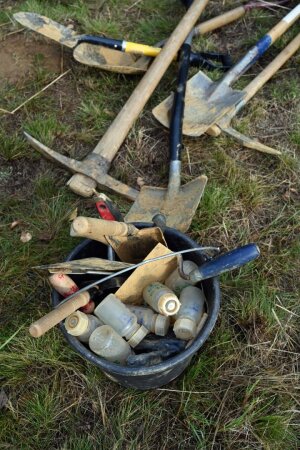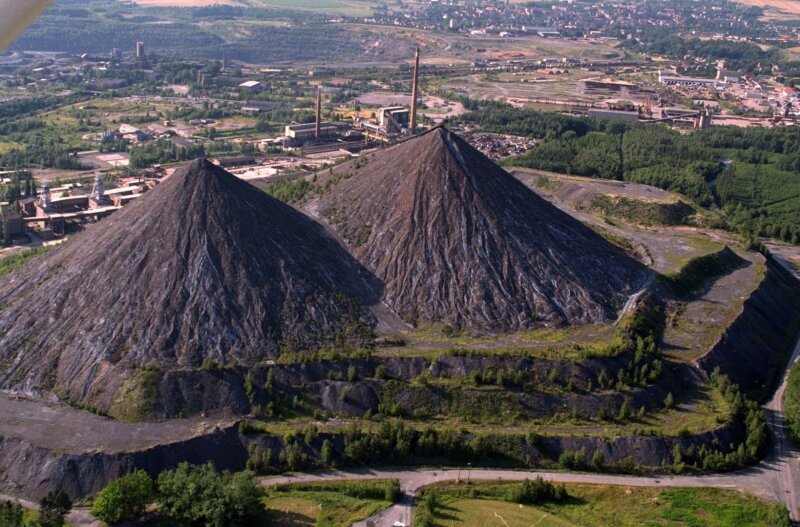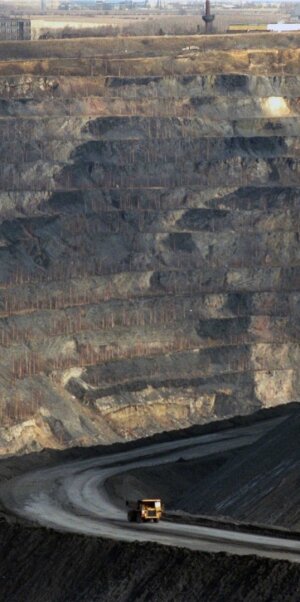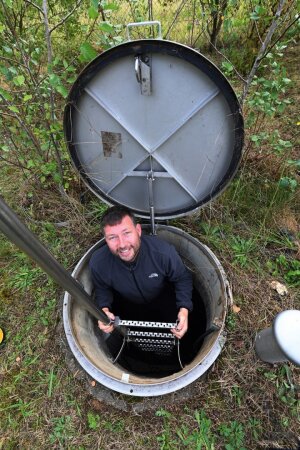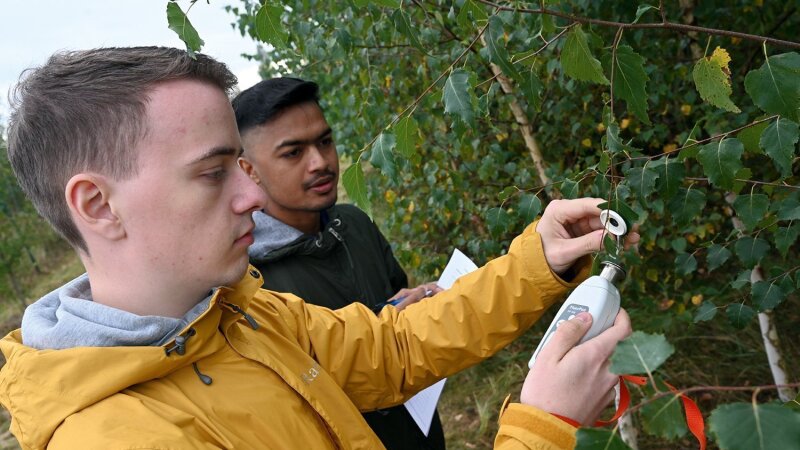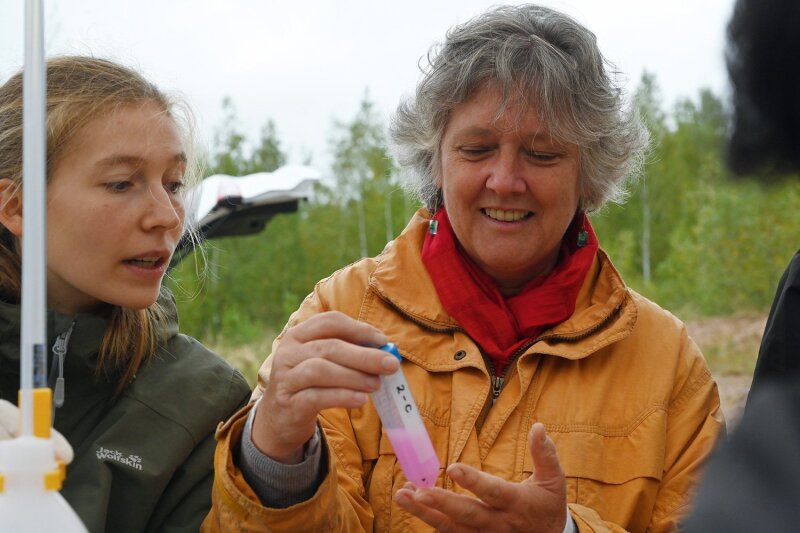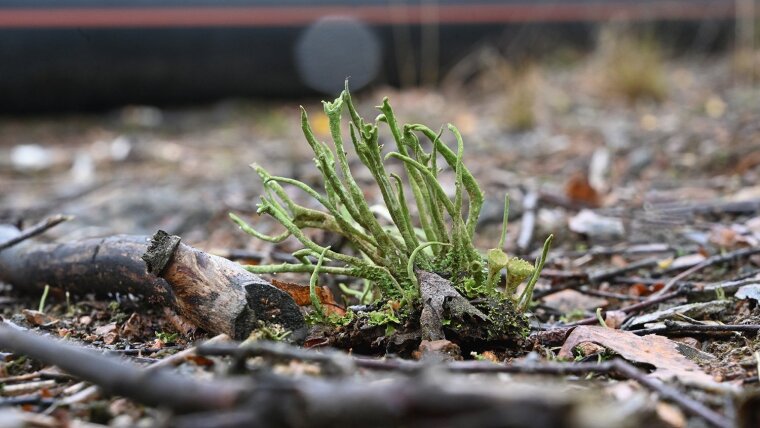
Around 40 kilometres to the east of Jena, on a meadow near Ronneburg, tiny organisms are fighting a huge environmental issue. Not a single blade of grass grew here for many years, as the soil had been contaminated by toxic metals—the sad legacy of a GDR uranium mine—but researchers from the University of Jena are helping nature back to its feet. They are using bacteria and fungi to enable the sustainable use of the area. Our author met with the researchers at the test field on the former heap leaching site.
It is around 11 o’clock on an autumnal Wednesday morning. I make a hesitant stride onto the narrow strip of dead earth that stretches out before me. There are no signs of life on the reddish brown soil, which is littered with pebbles. No blade of grass, not a single leaf, not a tiny bit of green. I am in a place near the town of Ronneburg in eastern Thuringia, where until a few decades ago, a huge mining heap soared into the sky. This is where the ore of Europe’s largest uranium reserve was mined, from which the Soviet Union produced nuclear weapons. »No plants can grow in this section,« says Prof. Dr Erika Kothe, who is standing next to me in her yellow wellington boots. »The water in the subsoil is too heavily contaminated with heavy metals«. In the areas where miners used to work up to 1990, the microbiologist is now directing a research project for the University of Jena to revitalize the soil on the former spoil heaps. How can microbiology, of all sciences, help the situation?
Various fieldwork and sampling tools are used during the annual field practical courses within the research project.
Image: Jan-Peter Kasper (University of Jena)Our journey begins at 8 o’clock in the morning outside a public park in Jena, where Erika Kothe is waiting for her team, which includes biologists, geoscientists, and students. Around twenty people in five cars, which are full to the brim with measuring equipment, plastic containers, and tools to be used throughout the day. Nobody is bothered when the rain starts to fall—everyone is wearing waterproofs and wellington boots.
And then our convoy sets off towards Winzerla via Rudolstädter Strasse before heading onto the A4 motorway towards Gera. Kothe doesn’t need a navigation device—she has driven along this route many times since the research project was launched in 2004. As her estate car cruises along the motorway, she tells me about the background to the project: In the days of the GDR, several thousand tons of uranium ore were mined by the »Soviet-East German stock company Wismut« in the area around Ronneburg. Some of the low-grade ore was stored on enormous overground heaps. Sulphuric acid was added to mobilize the uranium. How-ever, this process also released other heavy metals from the rock, such as iron and manganese, which seeped into the ground with the acid as waste products. The soil is still contaminated with metals to this day. They can end up in the groundwater, causing plants to grow poorly in the former mining areas. Another problem: The dead earth is exposed to the wind and rain, which could spread the contaminants even further into the surrounding area.
The area where the researchers are now planting trees looked a lot different in the 1990s.
Image: Jan-Peter Kasper (University of Jena)Landfarming on formerly contaminated soil
This is what the Jena-based researchers aim to prevent through the USER project. The German acronym stands for heavy metal landfarming for sustainable landscaping and the production of renewable energy in areas contaminated with radionuclides. Contaminated with radionuclides? Is the area still loaded with radioactive waste? »Ever since the area was completely redeveloped by Wismut GmbH after the mine had been closed, the levels of radioactivity have been minimal,« assures Kothe. At most, small amounts of radon are released like in other places with a similar geological subsoil, but the radiation dose is not harmful. »It might put your cells under a little stress, but that actually can help prevent rheumatism and arthritis—like a radon spa«.
I am not exactly relieved by her answer. I try to relax and notice that we have already left the A4 motorway. As the roads get narrower, we turn onto a dirt track before coming to a halt in a
meadow. We get out and hobble over a thin wooden footbridge that leads over a ditch and onto the »Gessenwiese«. The research enclosure is around half the size of a football pitch. The others have got there before us—some of the researchers have already started their work.
I notice a tidy row of young trees at the other end of the enclosure. »That’s our test field«, explains Kothe with pride. »Some of the trees are already six metres tall—and we only planted them three years ago«. They are growing in an area that used to be one of the largest spoil heaps in Europe, where ore was piled up to 45 metres high and leached with sulphuric acid, so that the metals could be collected in a solution at the foot of the heap. I take a closer look at the trees. Some of the alders, birches, and willows are bigger than the others; the alder trees are the tallest of the lot. That’s because the trees have been planted in soils with various types of biological and geological additives.
Microorganisms protect the trees against metals
For example, the researchers have added microorganisms to the soil, which protect the trees and other plants against toxic metals. Mycorrhizal fungi are also being used. They create a mutally
symbiotic relationship with their host trees by supplying water and nutrients from the soil and receiving photosynthesis products in return. Grasses like red fescue are also helping to protect the trees against erosion; and the carbonate-rich soil added from sources around Jena acts as a buffer to the acidic substrate present. Kothe disappears for a moment amongst the trees and returns with a small piece of root. She hands me the delicate structure. As I take a closer look, I see tiny bulges. »That’s another form of mutual symbiosis, this time between certain bacteria and alder roots,« says the professor. »The bacteria even ensure the supply of nitrogen to the tree, because they trap atmospheric nitrogen and thus reduce the need for fertilizer«. The researchers are using methods like these to find the combination of soil improvements, plants, fungi, and bacteria that can most effectively promote plant growth in the low-nutrient soil. This will allow the researchers to grow a plantation in the former mining area, which will ultimately provide the wood needed to generate renewable energy.
Dr Daniel Mirgorodsky climbs into a lysimeter through a hatch in the ground. The geologist uses this underground system to monitor the transfer of substances between the atmosphere, soil, and groundwater.
Image: Jan-Peter Kasper (University of Jena)
As the success of such a project is dependent on long-term documentation, the team has installed several measuring stations called »lysimeters« on site. Dr Daniel Mirgorodsky shows me what this is all about. The geologist opens a circular hatch in the ground, not much bigger than a manhole cover, and we climb into the darkness below. At a depth of around two metres, a musty smell hits my nostrils—we are standing in a damp cellar with three metal tanks. That must be the lysimeters.
»These tanks are on scales,« says Mirgorodsky. He is standing right in front of me—the cellar is just big enough for two people. »That is how we measure how much rain falls on the area and how quickly the water evaporates. Other measuring devices determine the metal content of the leachate that could potentially seep through the soil and into the groundwater«. I suddenly hear a beep coming from a box with green and red flashing lights on my left. I am looking at the radio station that transmits readings to the laboratories in Jena every 15 minutes. »You can’t just plant trees in this soil,« adds Mirgorodsky. »We have to check which plants can grow in which condition, and which combination of bacteria and fungi are capable of optimally supporting their growth—out in the field and in the
laboratory«.
Many tests, one objective: to develop the best method for growth
I say goodbye and climb outside, where the students have started their work in groups of three and four. I want to take a closer look at their different experiments; after all, they too are involved in the long-term observation of the research area. I start off at the plantation with the alders, birches and willows, where one of the groups is roaming through the densely vegetated area. The student at the front is carefully attaching clips to the green leaves of the trees, almost like she is decorating a Christmas tree. She is being followed closely by two other students, who are holding a measuring device against the clips, reading off values and entering them in a table. »This is how we measure the fluorescence,« explains the biologist Markus Riefenstahl, who is supervising the group. »We do this to check how well photosynthesis is working and determine how much stress the trees are under due to the soil contamination«.
As I walk away from the plantation, I bump into another group that has gathered around one of the many pipes that are sticking out of the ground throughout the site. Dr Arno Märten is responsible
here. »This pipe is a groundwater measuring station, where we monitor the groundwater table before conducting hydrochemical analysis in the lab,« explains the geologist. A student drops a water level meter into the pipe, which measures the depth as soon as it touches the water. He then uses a scoop pipe to collect a sample. Märten is happy with the water quality—the effects of the former spoil heaps are gradually wearing off. However, climate change is beginning to rear its ugly head: As a result of the extremely dry spells over the past two summers, several measuring
stations are currently without any water whatsoever.
»Leafclips« are used by the students Valentin Kurbel (left) and Hossain Mohammad to measure the vitality of the trees planted in the former mining area.
Image: Jan-Peter Kasper (University of Jena)I walk past a pair of white tents in which researchers are setting up equipment for an experiment and head over to the next group of students, who are in the middle of some strenuous-looking work. They are swinging around pickaxes and spades to dig a hole measuring around two metres in width. I take a look inside and discover various layers of soil in different colours: red and black strips sandwiched between sandy layers. The heavy metal contamination can be seen with the naked eye here: The red stuff is iron hydroxide (rust); the black colour is caused by manganese hydroxide. »These hydroxides lead to a build-up of rare earth elements,« explains Erika Kothe. »This area is ranked behind China as the place with the third highest concentration of rare earth elements in the water worldwide«.
-
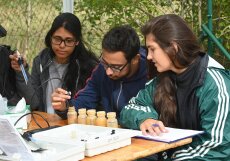
Die Studierenden Sarah Bhutta, De Sayantan und Franziska Zimmermann (v. l.) bestimmen den pH-Wert und die Leitfähigkeit von Bodenproben.
Image: Jan-Peter Kasper (University of Jena) -
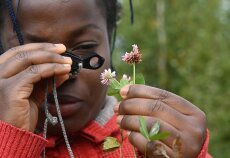
Hier ist gute Artenkenntnis gefragt: Odejide Tosin, Studentin im internationalen, englischsprachigen Masterstudiengang »Microbiology«, bestimmt alle Pflanzen in einem definierten Testareal.
Image: Jan-Peter Kasper (University of Jena) -
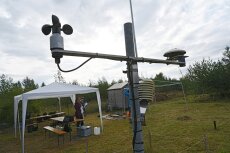
Auf der Gessenwiese bei Ronneburg hat das Forschungsteam eine automatische Wetterstation installiert, die Daten zu meteorologischen Größen wie Wind, Niederschlag und Temperatur erfasst.
Image: Jan-Peter Kasper (University of Jena) -
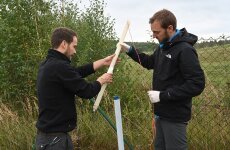
Dr. Arno Märten (l.) und Jonas Ruppert entnehmen Wasserproben für die hydrochemische Analyse.
Image: Jan-Peter Kasper (University of Jena)
Measuring soil respiration with jam jars
Now the microbiologist wants to show me the other test field. We get in the car and drive through a few villages and past a huge former heap site on our way to the Kanigsberg mining area. The researchers have set up another white tent here, where students are busy analysing the soil respiration. They are sitting patiently in front of their titration apparatuses and shaking tubes containing a pink solution, adding drops of diluted hydrochloric acid. The striking colour comes from phenolphthalein, an indicator used to visualize the change in the pH value in an alkaline solution that has been covered with a jam jar and left on the soil overnight. For every sample, they note how much acid is required until the pink solution turns colourless. This allows the researchers to establish how much carbonic acid has been produced during microbiological respiration in the form of CO2.
Lisa Schulz (left), a bachelor’s student in Biogeosciences, and Prof. Erika Kothe discuss the samples that are titrated to measure soil respiration. The phenolphthalein dye turns from pink to colourless when the pH becomes neutral. This is how the researchers can measure how much CO2 the microorganisms have produced.
Image: Jan-Peter Kasper (University of Jena)Kanigsberg is also home to the strip of dead earth where no plant grows. This situation is caused by a small spring on the slope; the water suppresses plant growth. As we pass through the area, I notice it is much more reminiscent of the mining industry than the Gessenwiese. The reddish brown tinge to the soil is more intense, and I even discover a black lump of ore among the many pebbles. And as we stand before the test field, I can see the effects: The trees here are much smaller than in the first field—despite being the same age. The alder trees are still the tallest, but the highest growth performance is measured for pines and birches. This is mainly because of the different, more gravelly soil, but the light conditions and proximity to other plants can also play a role.
All of a sudden, the rain comes pouring down. »That means it’s time for a lunch break,« announces Kothe with a wink On the benches in the tent, everyone huddles together to eat a slice of apple
cake brought along by the professor— she is clearly happy with her team’s performance. »Everyone pulls together here, whether they are a biologist or a geologist,« she says. This bodes well for the future of the project, which will run for a few more years. The researchers want to continue looking for the best combination of gentle and environmentally friendly methods; and they are looking to introduce additional measures to the project. They also plan to observe the area from the air using automated drones; and they are testing another analytical method which, in addition to plant growth, can measure soil formation and any changes caused by erosion. Furthermore, the geologist involved in the project, Prof. Dr Thorsten Schäfer, wants to conduct more detailed analyses of the transport
of bacteria and metals as nanoparticles in the water.
We leave around 13:30. Before I get back into Erika Kothe’s car, I take another look at the place. I am amazed that trees have started grow-ing in such a short space of time in an area which, in old pictures, looks like a rugged lunar landscape. Perhaps this might also work one day along the strip of dead earth—if necessary, it can always get a little kick-start from the world of science.
By Till Bayer
